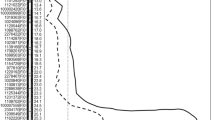Summary
We examined genetic variation for trichome production in a rapid-cycling population of Brassica rapa by conducting a selection experiment and by growing progeny from maternal seed families. Data from the maternal families were also used to estimate the genetic correlations between trichome number and (1) number of days to first flower and (2) flower production. For seven generations, 10% of the plants were selected from low, high and control lines with 100 individuals per line per generation. The number of trichomes on the right edge of the first leaf was 20.8 ± 13.4 (mean + SD; n=100) in the base population, and had by the final generation reached 93.9 ± 28.7 (n=100) in the high line and 0.9 ±2.6 (n=100) in the low line. Control line plants of the seventh generation did not differ significantly from base population plants in number of trichomes on the edge. The realized heritability of trichome number on the edge was 0.38 (based on the regression of cumulative response on cumulative selection differential). The divergence between lines in trichome production on the edge of the first leaf was associated with a divergence in trichome number on the petiole and on the top of the same leaf, and on the edge, top and petiole of the third leaf. The increase in trichome production in the high line was further associated with a significant delay in flowering time relative to the control and low lines. The estimated heritabilities of trichome number on the edge and the petiole of the first leaf and of days to first flower were not significantly different from 1.0 (based on the among maternal family component of the total variance). Trichome number on the edge showed a significant genetic correlation with trichome number on the petiole of the first leaf (r=0.80), and with number of days to first flower (r=0.31), but not with total flower production (r=0.17; n=83). The substantial genetic variation for trichome production in B. rapa is of potential value for breeding purposes and also makes B. rapa a convenient system for the study of plant-herbivore interactions.
Similar content being viewed by others
References
Becker WA (1984) Manual of quantitative genetics, 4th ed. Academic Enterprises, Pullman, WA
Chew FS (1988) Searching for defensive chemistry in the Cruciferae, or, do glucosinolates always control interactions of Cruciferae with their potential herbivores and symbionts? No! In: Spencer KC (ed) Chemical mediation of coevolution. Academic Press, London New York, pp 81–112
Evans AS (1991) Leaf physiological aspects of nitrogen-use efficiency in Brassica campestris L.: quantitative genetic variation across nutrient treatments. Theor Appl Genet 81:64–70
Falconer DS (1989) Introduction to quantitative genetics. Longman, London
Feeny P (1977) Defensive ecology of the Cruciferae. Ann M Bot Gard 64:221–234
Gómez-Campo C (1980) Morphology and morpho-taxonomy of the tribe Brassiceae. In: Tsunoda S, Hinata K, Gómez-Campo C (eds) Brassica crops and wild allies. Jpn Sci Press, Tokyo, pp 3–32
Hill WG (1972) Estimation of realized heritabilities from selection experiments. I. Divergent selection. Biometrics 28:747–765
Koornneef M, Dellaert LWM, van der Veen JH (1982) EMS- and radiation-induced mutation frequencies at individual loci in Arabidopsis thaliana (L.) Heynh. Mutat Res 93:109–123
Lamb RJ (1980) Hairs protect pods of mustard (Brassica hirta ‘Gisilba’') from flea beetle feeding damage. Can J Plant Sci 60:1439–1440
Lamb RJ (1989) Entomology of oilseed Brassica crops. Ann Rev Entomol 34:211–229
Levin DA (1973) The role of trichomes in plant defense. Quart Rev Biol 48:3–15
Marks MD, Feldmann KA (1989) Trichome development in Arabidopsis thaliana. I. T-DNA tagging of the Glabrousl gene. Plant Cell 1:1043–1050
Miller TE, Schemske DW (1990) An experimental study of competitive performance in Brassica rapa (Cruciferae). Am J Bot 77:993–998
Nishi S (1980) Differentiation of Brassica crops in Asia and the breeding of ‘HAKURAN’ a newly synthesized leafy vegetable. In: Tsunoda S, Hinata K, Gómez-Campo C (eds) Brassica crops and wild allies. Jpn Sci Press, Tokyo, pp 133–150
Norris DM, Kogan M (1980) Biochemical and morphological bases of resistance. In: Maxwell EG, Jennings PR (eds) Breeding plants resistant to insects. Wiley, New York, pp 23–61
Renwick JAA (1988) Comparative mechanisms of host selection by insects attacking pine trees and Crucifers. In: Spencer KC (ed) Chemical mediation of coevolution. Academic Press, London New York, pp 303–316
Sokal RR, Rohlf FJ (1981) Biometry, 2nd ed. WH Freeman, New York
Southwood R (1986) Plant surfaces and insects — an overview. In: Juniper B, Southwood R (eds) Insects and the plant surface. Arnold, London, pp 1–22
Stipanovic RD (1983) Function and chemistry of plant trichomes and glands in insect resistance. In: Hedin PA (ed) Plant resistance to insects. Am Chem Soc Symp Ser 208, Washington D.C., pp 69–100
Via S (1984) The quantitative genetics of polyphagy in an insect herbivore. II. Genetic correlations in larval performance within and across host plants. Evolution 38:896–905
Williams PH (1985) CrGC resource book. Department of Plant Pathology, University of Wisconsin-Madison
Williams PH, Hill CB (1986) Rapid-cycling populations of Brassica. Science 232:1385–1389
Author information
Authors and Affiliations
Additional information
Communicated by P. M. A. Tigerstedt
Rights and permissions
About this article
Cite this article
Ågren, J., Schemske, D.W. Artificial selection on trichome number in Brassica rapa . Theoret. Appl. Genetics 83, 673–678 (1992). https://doi.org/10.1007/BF00226683
Received:
Accepted:
Issue Date:
DOI: https://doi.org/10.1007/BF00226683




